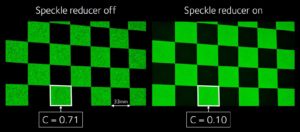Speckle Reducer for laser imaging, projection displays and sensors

A laser is often referred to as a device that emits a beam of light through a process of amplification.
High-brightness lasers are used in the field of life science, material science, medical diagnosis, and precision engineering for high-speed, high-resolution optical imaging. However, the random scattering in imaging systems, caused by coherent lasers, is a primary obstacle for optical imaging.
However, lasers come with some drawbacks that have hindered their widespread adoption.
The problem with speckle
When a laser beam of light is shone onto a screen, the image quality produced is degraded by a coherent artifact known as speckle. When the laser light is coherent, all the waves are in phase with each other, and when you shine a laser onto a screen the light is scattered in all directions because a screen isn’t flat on the scale of the wavelength of light. This means that laser light, from all over the screen, reaches your eye having travelled a range of distances to get there.
As a result, we see an image that appears “speckly” (a granular pattern superimposed over the intended image), and which changes as you move and your position relative to the screen changes. To be able to use lasers to produce high-quality images, this speckle pattern needs to be suppressed or removed entirely.
A better speckle reducer
There are some technologies, currently available, that address the problem. One method is to rotate or vibrate a diffuser rapidly which blurs out the speckle pattern. This comes with the costs of added bulk, moving parts and vibrations, power consumption and limited lifetime.
Most methods rely on vibrating something, so what if we take the idea of a moving diffuser a step further?
Rather than make a solid diffuser plate and shake it around mechanically, a transparent device has been created that uses a liquid crystalline material with an alternating electric field to ‘vibrate’ the molecules about. The electrohydrodynamic turbulence created inside the device causes blurring of laser-light passing through it which reduces speckle without physically moving the device. The device has a simple design, low manufacturing cost and consumes very little power.
Patent protection
A patent has been filed which covers this technology. Oxford University Innovation Ltd. is interested in talking to potential partners to aid in the commercialisation of this new device.
about this technology

